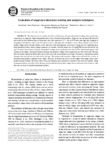Please use this identifier to cite or link to this item:
http://www.alice.cnptia.embrapa.br/alice/handle/doc/1005632| Title: | Evaluation of sugarcane laboratory ensiling and analysis techniques. |
| Authors: | PEDROSO, A. de F.  PEDROSO, A. M.   BARIONI JUNIOR, W.   SOUZA, G. B. de   |
| Affiliation: | ANDRE DE FARIA PEDROSO, CPPSE; ALEXANDRE MENDONCA PEDROSO, CPPSE; WALDOMIRO BARIONI JUNIOR, CPPSE; GILBERTO BATISTA DE SOUZA, CPPSE. |
| Date Issued: | 2014 |
| Citation: | Revista Brasileira de Zootecnia , v. 43, n. 4, p. 169-174, apr. 2014. |
| Description: | The objective was to evaluate the effects of laboratory-silo type and method of silage extract production, respectively, on sugarcane silage fermentation and recovery of fermentation products. Sugarcane was mechanically harvested and ensiled in three different types of laboratory silos (five replicates): 9.7 × 30 cm PVC tubes with tight lids, equipped or unequipped with Bunsen valves, and 20 L plastic buckets with tight lids and Bunsen valves. Three methods were used to produce silage extracts for pH, ethanol, acetic and lactic acids determination: extraction of silage juice by a hydraulic press and production of water extracts using a stomacher or a blender. Total dry matter loss (231 g/kg DM) was not affected by silo type. No interactions between silo type and method of silage extract production were observed for ethanol and organic acids contents in the silages. Interaction between silo type and method of silage extract preparation was detected for pH. Silo type affected ethanol content but did not affect lactic and acetic acids concentration in the silages. Dry matter, crude protein, neutral detergent fiber and ash were not affected by silo type. The method used to produce silage extracts affected the recovery of all fermentation products analyzed in the silages. Recovery of ethanol and acetic acid was higher when silage extracts were produced using a blender. For lactic acid recovery, the hydraulic press method was superior to the other two methods. Silage fermentation pattern is not affected by silo type, but the method used to produce silage extracts and some characteristics of silos affect the recovery of volatile fermentation products. |
| NAL Thesaurus: | acetic acid lactic acid |
| Keywords: | Ethanolc Laboratory silo Silage extract Sugarcane silage |
| ISSN: | 1806-9290 |
| DOI: | https://doi.org/10.1590/S1516-35982014000400002 |
| Type of Material: | Artigo de periódico |
| Access: | openAccess |
| Appears in Collections: | Artigo em periódico indexado (CPPSE)  |
Files in This Item:
| File | Description | Size | Format | |
|---|---|---|---|---|
| PROCI2014.00220.pdf | 256,88 kB | Adobe PDF |  View/Open |









